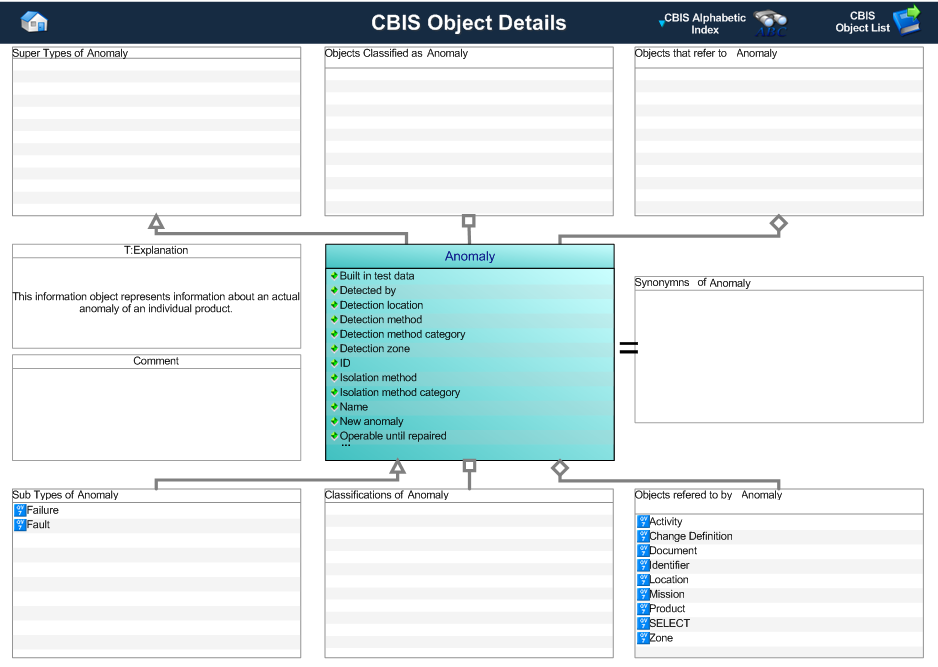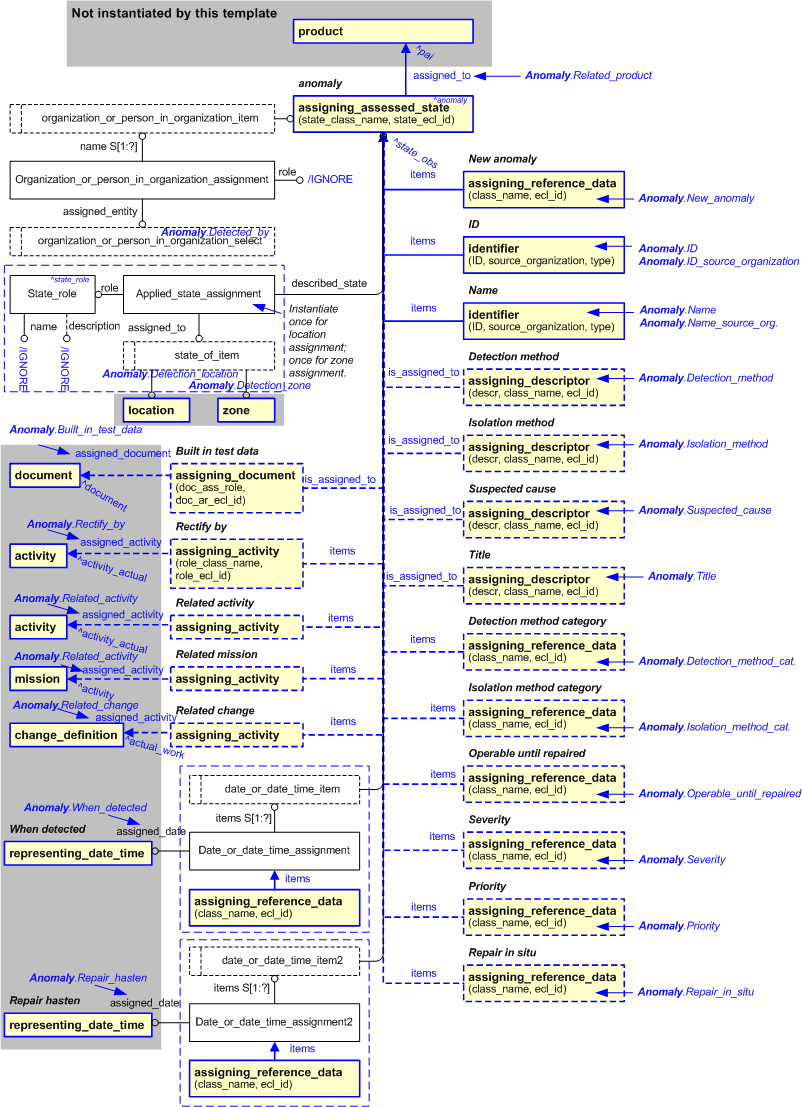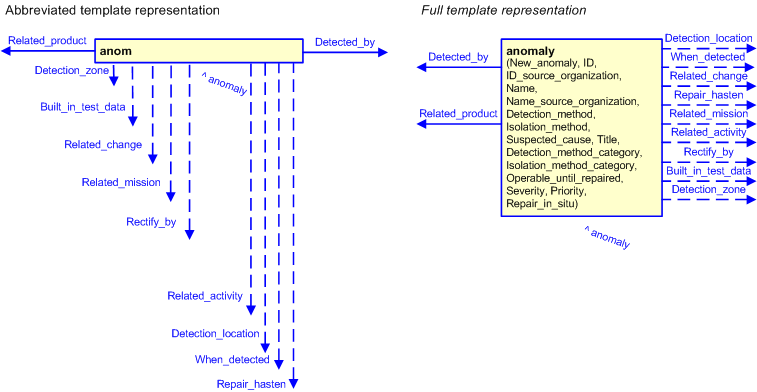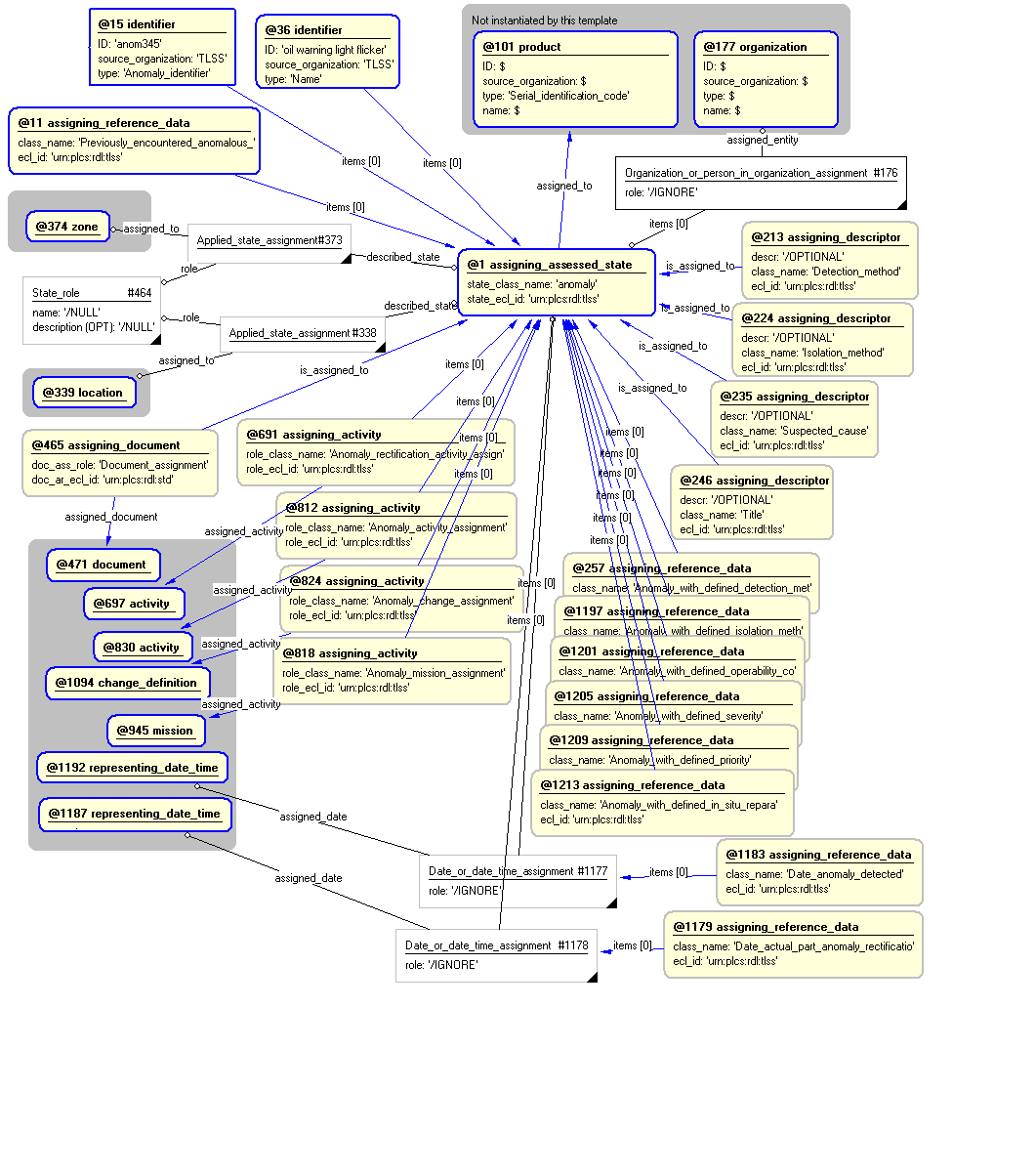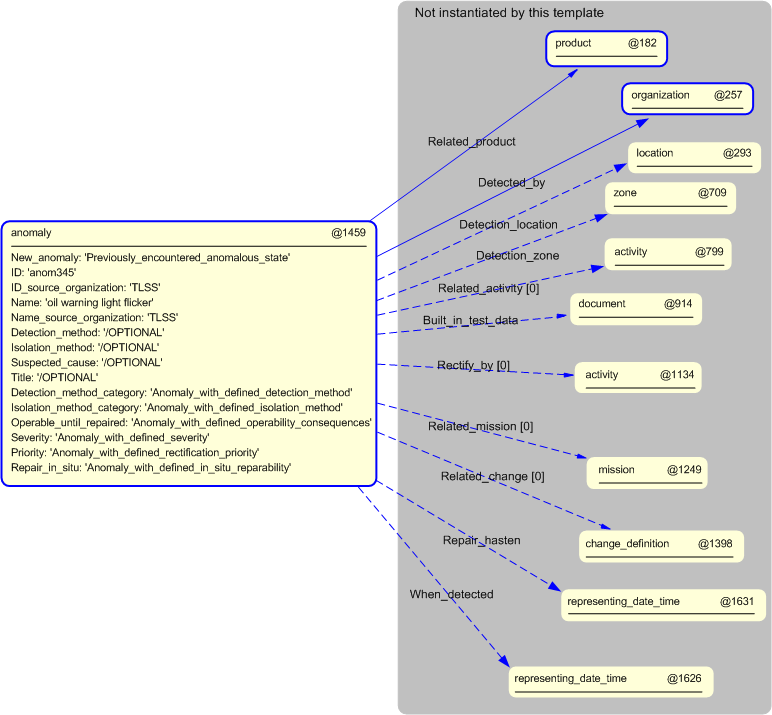Template:— anomaly (anom)
Context:— UK_Defence |
Date: 2010/03/18 09:45:45
Revision: 1.3
|
This section specifies the template anomaly.
NOTE
The template has been defined in the context of
UK_Defence.
Refer to the business context for details of related templates.
NOTE
An explanation of a template and the associated instantiation path is
provided in the
Template overview
section.
This template describes how to represent the UK_Defence concept of an anomaly
in terms of PLCS model elements (templates, entities, and reference data).
This template describes how to represent UK_Defence anomaly using
State_assessment
This information object represents information about an actual anomaly of an individual product. The sub types of Anomaly,
e.g. defect, fault, failure, are described in their own templates.
Figure 1 — Graphical Representation for Business Object Anomaly
Anomaly
The definition of a anomaly object is:
This information object represents information about an actual anomaly of an individual product.
|
Attribute name
|
Attribute description
|
Attribute type
|
Optionality
|
| Built in test data |
This is the reference to the BITE code and / or data that is associated with the anomaly |
Document |
Optional |
| Detected by |
This is the reference to the person / organization / system that detected the anomaly |
Relationship to Person, Organization, Information system (SELECT)
|
Mandatory |
| Detection location |
This is the reference to the geographic location of the related product when the anomaly was detected |
Location |
Optional |
| Detection method |
This is the description of the method used to detect the anomaly.
NOTE: This should include whether any predefined tasks were used
|
Intrinsic |
Optional |
| Detection method category |
This is the category of detection method by which the anomaly was detected, including whether it was detected by built in
test equipment.
|
Intrinsic |
Optional |
| Detection zone |
This is the reference to the zone of the product in which the anomaly was detected. |
Zone |
Optional |
| ID |
This is the identifier of the anomaly. |
Identifier |
Mandatory |
| Isolation method |
This is the description of the method used to isolate the anomaly.
NOTE: This should include whether any predefined tasks were used.
|
Intrinsic |
Optional |
| Isolation method category |
This is the category of isolation method by which the anomaly was isolated. |
Intrinsic |
Optional |
| Name |
This is the name given to the anomaly. |
Intrinsic |
Mandatory |
| New anomaly |
This is an indicator as to whether the anomaly is a new type of anomaly |
Intrinsic |
Mandatory |
| Operable until repaired. |
This is an indicator as to whether the product to which the anomaly is related, is operable until the anomaly is repaired. |
Intrinsic |
Optional |
| Priority |
This is the priority of rectifying the anomaly. |
Intrinsic |
Optional |
| Rectify by |
This is the reference to the related activity that will / has rectified the anomaly.
NOTE: It is assumed that if more than one activity is required, the one referenced will structure those other
activities accordingly in terms of sequence and concurrency
|
Activity |
Optional |
| Related activity |
This is the reference to the activity that was being performed when the anomaly was detected. |
Activity |
Optional |
| Related change |
This is the reference to a change that may be associated with the anomaly. |
Change Definition |
Optional |
| Related mission. |
This is the reference to the mission (and hence the related theatre and scenario) in which the anomaly occurred. |
Mission |
Optional |
| Related product |
This is the reference to the product on which the anomaly occurred |
Product |
Mandatory |
| Repair hasten |
This is the date and time on which the activity to rectify the anomaly is hastened. |
Intrinsic |
Optional |
| Repair in situ |
This is an indicator of whether the anomaly can be rectified with the related product in situ (in its normal operating location). |
Intrinsic |
Optional |
| Severity |
This is the category of severity of the anomaly. |
Intrinsic |
Optional |
| Suspected cause |
This is a description of the suspected cause of the anomaly (including suspected software failure) at the time that the anomaly
was recorded
|
Intrinsic |
Optional |
| Title |
This is the title given to the anomaly. |
Intrinsic |
Optional |
| When detected |
This is the date and time on which the anomaly was first detected. |
Intrinsic |
Optional |
Table 1 — Anomaly attribute details
The EXPRESS-G diagram in
Figure
2
shows the templates and EXPRESS entities that are required
to represent the template
"anomaly".
The text highlighted in blue shows the template parameters.
Figure 2 — An EXPRESS-G representation of the Information model for anomaly
The graphic for the template to be used in other EXPRESS-G diagrams
is shown in Figure
3
below.
Figure 3 — The graphical representation of the anomaly template
The following input parameters are defined for this template:
This is the reference to the product on which the anomaly occurred.
New_anomaly (Default=Anomalous_state_of_unknown_novelty,Type='STRING')
This is an indicator as to whether the anomaly is a new type of anomaly.
This is the identifier of the anomaly.
The organization that created the associated identifier. Additionally
a Person or Information System could be defined when either of these are the source; see Identifier template characterizations
This is the name given to the anomaly.
The organization that created the associated name.
The method used to detect the anomaly.
The method used to isolate the anomaly.
The suspected cause of the anomaly.
Title (Default=/OPTIONAL,Type='STRING', Optional)
The title given to the anomaly.
The category of the method by which the anomaly was detected
The following classes and their sub-classes can be used:
classifications: [Anomaly_with_defined_detection_method]![[warning:]](../../../../../../images/dex/warning.gif) Error RDL4: The URI urn:plcs:rdl:uk_defence is not listed in dexlib/data/refdata/rdl_index.xml
Error RDL4: The URI urn:plcs:rdl:uk_defence is not listed in dexlib/data/refdata/rdl_index.xml
The category of the method by which the anomaly was isolated.
The following classes and their sub-classes can be used:
classifications: [Anomaly_with_defined_isolation_method]![[warning:]](../../../../../../images/dex/warning.gif) Error RDL4: The URI urn:plcs:rdl:uk_defence is not listed in dexlib/data/refdata/rdl_index.xml
Error RDL4: The URI urn:plcs:rdl:uk_defence is not listed in dexlib/data/refdata/rdl_index.xml
A "flag" that is used to indicate whether the product to which the anomaly is related can continue to be operted
until the anomaly is repaired.
The following classes and their sub-classes can be used:
classifications: [Anomaly_with_defined_operability_consequences]![[warning:]](../../../../../../images/dex/warning.gif) Error RDL4: The URI urn:plcs:rdl:uk_defence is not listed in dexlib/data/refdata/rdl_index.xml
Error RDL4: The URI urn:plcs:rdl:uk_defence is not listed in dexlib/data/refdata/rdl_index.xml
Severity (Default=State_observed,Type='CLASS', Optional)
The category of severity of the anomaly.
The following classes and their sub-classes can be used:
classifications: [Anomaly_with_defined_severity]![[warning:]](../../../../../../images/dex/warning.gif) Error RDL4: The URI urn:plcs:rdl:uk_defence is not listed in dexlib/data/refdata/rdl_index.xml
Error RDL4: The URI urn:plcs:rdl:uk_defence is not listed in dexlib/data/refdata/rdl_index.xml
Priority (Default=State_observed,Type='CLASS', Optional)
The priority of rectifying the anomaly.
The following classes and their sub-classes can be used:
classifications: [Anomaly_with_defined_rectification_priority]![[warning:]](../../../../../../images/dex/warning.gif) Error RDL4: The URI urn:plcs:rdl:uk_defence is not listed in dexlib/data/refdata/rdl_index.xml
Error RDL4: The URI urn:plcs:rdl:uk_defence is not listed in dexlib/data/refdata/rdl_index.xml
An indicator of whether the anomaly can be rectified with the related product in situ (in its normal operating location).
The following classes and their sub-classes can be used:
classifications: [Anomaly_with_defined_in_situ_reparability]![[warning:]](../../../../../../images/dex/warning.gif) Error RDL4: The URI urn:plcs:rdl:uk_defence is not listed in dexlib/data/refdata/rdl_index.xml
Error RDL4: The URI urn:plcs:rdl:uk_defence is not listed in dexlib/data/refdata/rdl_index.xml
This is the reference to the person / organization / system that detected the anomaly.
The reference to the geographic location of the related product when the anomaly was detected.
The reference to the zone of the product in which the anomaly was detected.
The reference to the BITE code and / or data that is associated with the anomaly
The reference to the related activity that will / has rectified the anomaly.
The reference to the activity that was being performed when the anomaly was detected.
The reference to the mission (and hence the related theatre and scenario) in which the anomaly occurred.
The reference to a change that may be associated with the anomaly.
The date and time when the repair was hastened.
The date and time when the anomaly was detected.
The following reference parameters are defined for this template:
Allow the
State_observed
entity instantiated in this path to be referenced when this template is used.
Note: The
State_observed
entity can be referenced in a template path by:
%^target = $anomaly.anomaly%
The following parameter combinations specify a uniqueness constraint:
Unique constraint: Unique anomaly
Each instance of the
entity
(
State_observed)
within the data set shall be uniquely identified
by a combination of the following parameters on this
template (anomaly) namely:
ID,
Name,
Related_product.
The
instance is
referenced by the following template parameter:
anomaly.
The instantiation path shown below specifies the entities that are to be
instantiated by the template.
A description of templates and the syntax for the instantiation path is
provided in the
Templates Help/Information section.
/
assigning_assessed_state(
state_class_name="anomaly",
state_ecl_id='urn:plcs:rdl:uk_defence',
assigned_to=@Related_product)/
%^anomaly = $assigning_assessed_state.state_obs%
-- New anomaly (mandatory) /
assigning_reference_data(
items=^anomaly,
class_name=@New_anomaly,
ecl_id='urn:plcs:rdl:uk_defence')/
-- ID (mandatory) /
identifier(
ID=@ID,
source_organization=@ID_source_organization,
type='Anomaly_identifier',
items=^anomaly)/
-- Name (mandatory) /
identifier(
ID=@Name,
source_organization=@Name_source_organization,
type='Name',
items=^anomaly)/
-- [optional Detection_method] /
assigning_descriptor(
descr=@Detection_method,
class_name='Detection_method',
ecl_id='urn:plcs:rdl:uk_defence',
is_assigned_to=^anomaly)/
-- [optional Isolation_method] /
assigning_descriptor(
descr=@Isolation_method,
class_name='Isolation_method',
ecl_id='urn:plcs:rdl:uk_defence',
is_assigned_to=^anomaly)/
-- [optional Suspected_cause] /
assigning_descriptor(
descr=@Suspected_cause,
class_name='Suspected_cause',
ecl_id='urn:plcs:rdl:uk_defence',
is_assigned_to=^anomaly)/
-- [optional Title] /
assigning_descriptor(
descr=@Title,
class_name='Title',
ecl_id='urn:plcs:rdl:uk_defence',
is_assigned_to=^anomaly)/
-- [optional Detection_method_category] /
assigning_reference_data(
items=^anomaly,
class_name=@Detection_method_category,
ecl_id='urn:plcs:rdl:uk_defence')/
-- [optional Isolation_method_category] /
assigning_reference_data(
items=^anomaly,
class_name=@Isolation_method_category,
ecl_id='urn:plcs:rdl:uk_defence')/
-- [optional Operable_until_repaired] /
assigning_reference_data(
items=^anomaly,
class_name=@Operable_until_repaired,
ecl_id='urn:plcs:rdl:uk_defence')/
-- [optional Severity] /
assigning_reference_data(
items=^anomaly,
class_name=@Severity,
ecl_id='urn:plcs:rdl:uk_defence')/
-- [optional Priority] /
assigning_reference_data(
items=^anomaly,
class_name=@Priority,
ecl_id='urn:plcs:rdl:uk_defence')/
-- [optional Repair_in_situ] /
assigning_reference_data(
items=^anomaly,
class_name=@Repair_in_situ,
ecl_id='urn:plcs:rdl:uk_defence')/
-- Detected by (mandatory) Organization_or_person_in_organization_assignment-- Set the Organization_or_person_in_organization_assignment attribute role to be ignored Organization_or_person_in_organization_assignment.role = '/IGNORE'
-- Assign the Organization_or_person_in_organization_assignment to the anomaly Organization_or_person_in_organization_assignment.items ->
^anomaly
-- Create the Detected_by parameter Organization_or_person_in_organization_assignment.assigned_entity ->
@Detected_by-- [optional Detection location] State_roleState_role.name = '/IGNORE'
State_role.description = '/IGNORE'
%^state_role_loc =
State_role%
Applied_state_assignmentApplied_state_assignment.role ->
^state_role_loc
Applied_state_assignment.described_state ->
^anomaly
Applied_state_assignment.assigned_to ->
@Detection_location-- [optional Detection zone] State_roleState_role.name = '/IGNORE'
State_role.description = '/IGNORE'
%^state_role_zone =
State_role%
Applied_state_assignmentApplied_state_assignment.role ->
^state_role_zone
Applied_state_assignment.described_state ->
^anomaly
Applied_state_assignment.assigned_to ->
@Detection_zone-- [optional Built in test data] /
assigning_document(
doc_ass_role='Document_assignment',
doc_ar_ecl_id='urn:plcs:rdl:std',
assigned_document=@Built_in_test_data,
is_assigned_to=^anomaly)/
-- [optional Rectify by] /
assigning_activity(
role_class_name='Anomaly_rectification_activity_assignment',
role_ecl_id='urn:plcs:rdl:uk_defence',
assigned_activity=@Rectify_by,
items=^anomaly)/
-- [optional Related activity] /
assigning_activity(
role_class_name='Anomaly_activity_assignment',
role_ecl_id='urn:plcs:rdl:uk_defence',
assigned_activity=@Related_activity,
items=^anomaly)/
-- [optional Related mission] /
assigning_activity(
role_class_name='Anomaly_mission_assignment',
role_ecl_id='urn:plcs:rdl:uk_defence',
assigned_activity=@Related_mission,
items=^anomaly)/
-- [optional Related change] /
assigning_activity(
role_class_name='Anomaly_change_assignment',
role_ecl_id='urn:plcs:rdl:uk_defence',
assigned_activity=@Related_change,
items=^anomaly)/
-- [optional Repair hasten] Date_or_date_time_assignmentDate_or_date_time_assignment.items ->
^anomaly
Date_or_date_time_assignment.assigned_date ->
@Repair_hasten%^hasten_date_time =
Date_or_date_time_assignment%
/
assigning_reference_data(
items=^hasten_date_time,
class_name='Date_actual_part_anomaly_rectification_hastened',
ecl_id='urn:plcs:rdl:uk_defence')/
-- [optional When detected] Date_or_date_time_assignmentDate_or_date_time_assignment.items ->
^anomaly
Date_or_date_time_assignment.assigned_date ->
@When_detected%^detect_date_time =
Date_or_date_time_assignment%
/
assigning_reference_data(
items=^detect_date_time,
class_name='Date_anomaly_detected',
ecl_id='urn:plcs:rdl:uk_defence')/
The following entities are instantiated with attributes as specified:
The instance diagram in Figure
4
shows an example of the EXPRESS entities and templates that are instantiated by the template:
/anomaly(New_anomaly='Previously_encountered_anomalous_state', ID='anom345', ID_source_organization='UK_Defence', Name='oil warning light flicker', Name_source_organization='UK_Defence', Detection_method='/OPTIONAL', Isolation_method='/OPTIONAL', Suspected_cause='/OPTIONAL', Title='/OPTIONAL', Detection_method_category='State_observed', Isolation_method_category='State_observed', Operable_until_repaired='State_observed', Severity='State_observed', Priority='State_observed', Repair_in_situ='State_observed', Related_Product='@182', Detected_by='@257')/
(an illustration of the consolidated anomaly template is shown in
Figure
5 below.)
Figure 4 — Entities instantiated by anomaly template
The instance diagram in
Figure
5
shows the graphic symbol for the template that is to be
used in other instance diagrams. The example template is:
/anomaly(New_anomaly='Previously_encountered_anomalous_state', ID='anom345', ID_source_organization='UK_Defence', Name='oil warning light flicker', Name_source_organization='UK_Defence', Detection_method='/OPTIONAL', Isolation_method='/OPTIONAL', Suspected_cause='/OPTIONAL', Title='/OPTIONAL', Detection_method_category='State_observed', Isolation_method_category='State_observed', Operable_until_repaired='State_observed', Severity='State_observed', Priority='State_observed', Repair_in_situ='State_observed', Related_Product='@182', Detected_by='@257')/
Figure 5 — Instantiation of anomaly template
Characterizations
No common characterizations of the template
anomaly
have been identified. However, the ISO 10303-239 EXPRESS model
may enable other assignments to the entities instantiated by the template.
